Description
The sarcophagus's relief represents the mythological scene of Bacchus's triumph over the Indies in his youth. It is made up of two registers.
One is vertical, with a group of figures around the central figure of Pan looking backwards and wearing a nebris (a panther skin, a symbolic attribute like Bacchus's deerskin or Hercules's lion skin), and the other horizontal from top to bottom, with genre scenes. A child-Pan stands between Pan's legs, holding a lagobolon (a stick used for hunting hare) and playing the flute. [4]
Either side of Pan is a group of six figures. On the left hand side of the relief is Bacchus in his triumphal chariot, decorated with acanthus foliage and drawn by two panthers (his favoured animals) in the foreground. He holds his thyrsus in his right hand and wears a royal tunic as worn by Hellenistic sovereigns and a woman's chiton covered by a nebris belted at the waist. He is crowned by a Victory standing behind him and holding a palm in her left hand. To Bacchus's right sits Ariadne, crowned with foliage but with her body partly hidden by a Bacchante.
The right hand group illustrates Bacchus's triumph over India with exotic figures - captives wearing a short tunic, mantle and barbarian German trousers and with braided hairstyles. One of them rides an elephant whose trunk and tusks were carved in very high relief and have not survived. The elephant's face is covered in corymbs, his body is covered in a net and his neck bears a bell. Between the elephant's forefeet is a lion, and behind him are exotic animals from the Orient and Africa - camel or giraffe. To the extreme left is Hercules in his lionskin, trying to approach a nymph who pushes her right hand against his shoulder. He appears to struggle but is supported by a satyr.
Hercules's drunkenness is associated with the cult of Bacchus and (having travelled to the ends of the earth) his presence is another indicator of a foreign land. The link between Bacchus and Hercules is confirmed by the figure of Silenus. [5]
In the top right corner is a shepherd lying between two goats and accompanied by a genius loci . [5] The space between the main figures is occupied by smaller elements, such as squatting goats. The short sides of the sarcophagus are carved in bas relief - the left side has a smiling Pan or satyr holding a lagobolon and a flute, with a stone cyst with a serpent slithering from it and with a bacchante next to him playing a tambourine; on the right side is a satyr approaching a Bacchante before a garlanded altar with fruits and pine cones.

In Ancient Greece a thyrsus or thyrsos was a wand or staff of giant fennel covered with ivy vines and leaves, sometimes wound with taeniae and topped with a pine cone, artichoke, fennel, or by a bunch of vine-leaves and grapes or ivy-leaves and berries, carried during Hellenic festivals and religious ceremonies. The thyrsus is typically associated with the Greek god Dionysus, and represents a symbol of prosperity, fertility, and hedonism similarly to Dionysus.

The Mildenhall Treasure is a large hoard of 34 masterpieces of Roman silver tableware from the fourth century AD, and by far the most valuable Roman objects artistically and by weight of bullion in Britain. It was found at West Row, near Mildenhall, Suffolk, in 1942. It consists of over thirty items and includes the Great Dish which weighs over 8 kg (18 lb).

In Greek mythology and religion, the thiasus was the ecstatic retinue of Dionysus, often pictured as inebriated revelers. Many of the myths of Dionysus are connected with his arrival in the form of a procession. The grandest such version was his triumphant return from "India", which influenced symbolic conceptions of the Roman triumph and was narrated in rapturous detail in Nonnus' Dionysiaca. In this procession, Dionysus rides a chariot, often drawn by big cats such as tigers, leopards, or lions, or alternatively elephants or centaurs.

The Loves of the Gods is a monumental fresco cycle, completed by the Bolognese artist Annibale Carracci and his studio, in the Farnese Gallery which is located in the west wing of the Palazzo Farnese, now the French Embassy, in Rome. The frescoes were greatly admired at the time, and were later considered to reflect a significant change in painting style away from sixteenth century Mannerism in anticipation of the development of Baroque and Classicism in Rome during the seventeenth century.

The study of Roman sculpture is complicated by its relation to Greek sculpture. Many examples of even the most famous Greek sculptures, such as the Apollo Belvedere and Barberini Faun, are known only from Roman Imperial or Hellenistic "copies". At one time, this imitation was taken by art historians as indicating a narrowness of the Roman artistic imagination, but, in the late 20th century, Roman art began to be reevaluated on its own terms: some impressions of the nature of Greek sculpture may in fact be based on Roman artistry.

The Church of Saint-Nizier is a church in the Presqu'île district of Lyon, France, in the 2nd arrondissement, between the Place des Terreaux and the Place des Jacobins. Its name refers to Nicetius of Lyon, a bishop of the city during the 6th century. Begun in the 14th century and only completed in the 19th century, the church contains a variety of architectural styles, ranging from the neo-Gothic spire to the classical Renaissance facade. In 1998, it was inscribed on the UNESCO World Heritage List along with other historic buildings in Lyon.

The Triumph of Bacchus is a painting by Diego Velázquez, now in the Museo del Prado, in Madrid. It is popularly known as Los borrachos or The Drinkers.
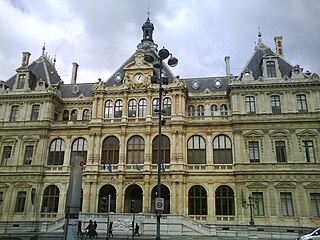
Les Cordeliers is one of the central quarters in the 2nd arrondissement of Lyon, France. It is mainly known for the Place des Cordeliers in its centre. Around the square, there are many notable monuments, including the Église Saint-Bonaventure and the Palais de la Bourse.

Lugdunum, formerly known as the Gallo-Roman Museum of Lyon-Fourvière, is a museum of Gallo-Roman civilisation in Lyon. Previously presented at the Museum of Fine Arts of Lyon and the Antiquarium, the municipal Gallo-Roman collection was transferred to a new building designed by Bernard Zehrfuss and opened in 1975, near the city's Roman theatre and odeon, on a hill known as Fourvière, located in the heart of the Roman city. Internally, it is formed of a concrete spiral ramp descending and branching out into the display rooms. It is managed and operated by the Metropolis of Lyon jointly with the archaeological museum of Saint-Romain-en-Gal. As well as displaying its own permanent collections of Roman, Celtic and pre-Roman material, a plan-relief of the ancient town and scale models of its major monuments such as the theatre and the Odeon, it also regularly hosts temporary exhibitions. On November 8, 2017, the museum was renamed Lugdunum.
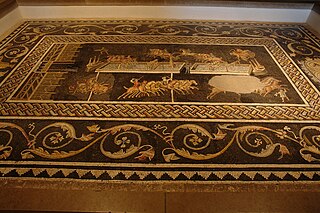
The Circus Games Mosaic is a 2nd-century Roman mosaic depicting a chariot race in quadrigas. It was discovered in 1806 in the Ainay district of Lyon and is now on display in the Gallo-Roman Museum of Lyon.

The Rue de l'Université is a large street in the 7th arrondissement of Lyon which connects the Pont de l'Université and the Avenue Jean-Jaurès. It is extended to the east by the rue Marc Bloch then the route de Vienne. It was named after the presence of several university buildings, built at the end of the nineteenth century starting in 1884.
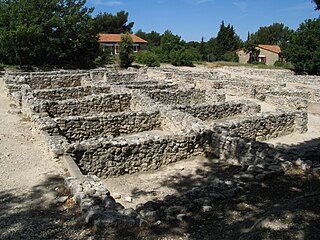
Entremont is a 3.5-hectare (8.6-acre) archaeological site three kilometres from Aix-en-Provence at the extreme south of the Puyricard plateau. In antiquity, the oppidum at Entremont was the capital of the Celtic-Ligurian confederation of Salyes. It was settled between 180 and 170 B.C., somewhat later than the inhabitation of other oppida, such as Saint-Blaise. The site was abandoned when it was taken by the Romans in 123 B.C. and replaced by Aquae Sextiae, a new Roman city founded at the foot of the plateau. By 90 B.C., the former oppidum was completely uninhabited.
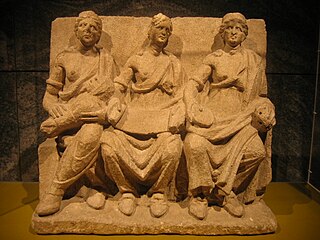
The Vertault relief is a Roman relief from Vertault, the ancient Vertillum, in the Department of Côte-d'Or. Today it is located at the Museum of Châtillon-sur-Seine.
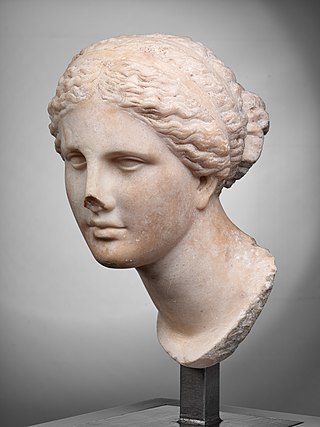
The Venus of Martres is a sculpture fragment from an antique replica of the Aphrodite of Knidos. The replica was made around the first century of the common era. It is on display at Musée Saint-Raymond in Toulouse, France.

The Velletri Sarcophagus is a Roman sarcophagus from 140–150 CE, displaying Greek and possible Asiatic influence. It features Hercules and other pagan deities framed by columned registers of classic spiral-fluted Doric and Ionic columnar styles, creating a theatrical border around the figures. It was created shortly after the Roman conversion to burial practice when Romans went from using cremation to burying their dead, due to new ideas of an afterlife.

The Triumph of Bacchus is a painting by the Walloon artist Michaelina Wautier. It was painted between 1650 and 1656 and is one of Wautier's greatest works, as well as her largest. Based on classical texts, the picture shows a procession with the drunken god Bacchus at its centre, surrounded by other humans, satyrs, and animals. It is notable for its large number of nude male figures, something uncommon from a woman artist in this period.

Nebris is a fawn skin, similar to an aegis, originally worn as a hunter's clothing item and later attributed to Dionysus.

The Roman villa of Chiragan is a Roman villa located in Martres-Tolosane (France).
A Statue of Heracles stands in the Parc Mauresque in Arcachon, in the southwestern French department of Gironde. The marble statue by local sculptor Claude Bouscau was installed in 1948 to commemorate the actions of the French Resistance in fighting German occupying forces during the Second World War. The statue of the ancient Greek hero Heracles stands 3.1 metres (10 ft) tall, nude except for the skin of the defeated Nemean lion.


















